Our all
In many types of business, especially in IT, employee competence is key. Beaten, familiar to all phrase. On the websites of most companies, where there is a section of mission or values, something is written like "our main wealth is our employees."
The phrase, though beaten, but I agree with her. Our business is exactly that. His success and failures are completely dependent on us, his employees. And it does not matter what kind of activities we are talking about - sales, marketing, development, maintenance, debugging, publishing, negotiations - all this is done by people , i.e. we.
And that's what happens. The success of a business depends on the competencies of its employees. We, like you, are trying to run a business. We count money, production, we manage tasks, we try to do something with projects, we calculate taxes ... We manage everything that is possible, except for what? Competences.
That is the most important thing we do not manage .
The first . We only roughly imagine what competencies we are talking about. Of course, if a business is built on performing one or two types of work, then management is not required. And if the types of work - dozens, and employees - hundreds?
What competencies do we already have? What is missing? What we dare not even threaten? What competencies do our clients need? A new product can we make, having only our competencies? Or maybe we lack one or two competencies to enter another market?
The second. We are poorly aware of the development of competencies. Approximately, in large strokes, we understand: Kohl is a specialist in the reactor, and Vasya is good at writing selling texts. And Gena? And who owns the angular? And what about the “Holding Management”? Do we have ERP competencies? And then everyone sells it, and we are on the sidelines. It seems that Seryoga knows something about ERP ... But what, and how well?
Third. We are accustomed to measure the acquisition of competencies by passing courses and certificates. Although we understand that real competencies are born only by practical work. But, since we do not measure the development of competencies, we have to be content with a surrogate - diplomas, courses and certificates. Undoubtedly, obtaining paperwork has a definite influence on competences, but this is only a starting impulse, followed by the application of theoretical knowledge in practice. But in reality, what happens with this impulse?
Fourth. Competences do not live in the head forever. Today I solved the task of a new technology for myself, I did not return to it for a couple of months, then I sat down - you do not remember anything. Some remnants of knowledge are present, of course, but "take and do" will not work anyway - you still have to figure it out. What can I say, even in your code, it is not always easy to figure out.
On the other hand, if competence is used regularly, then it comes to automatism and ceases to be a problem. It turns out that you need to measure and maintain this regularity in order not to lose competence.
The fifth . Business often depends on competencies. Sometimes - very much.
For example, if there is an employee with unique skills. If he leaves, the whole business line may close, at least for a while.
Competences often form a sales structure. If we have few ERP specialists, then a natural limit to the sales of services in this class of solutions is formed - it is equal to the physical ability to work out for these competent people. If competencies are not managed, then the business has to “get the volume” by other activities, often less in demand and more risky.
Sometimes the cart is placed in front of the horse. We form a sales portfolio based on competencies, and not vice versa . We train employees, pay money for it, and then we hope that sales will change, in terms of volume and structure.
But the reality remains in place - competencies manage the business . Form constraints that we have to take into account.
Sixth. There is a constantly smoldering conflict between employees and business, in terms of competencies. The person, as a rule, wants to “sit on the topic” - to master a small range of competencies, if possible - to become an expert in it, and take a considerable part of the work on the chosen topics.
A person is good, and business is not bad. But if a company needs to master new competencies? For business, this is a risk, for a person - all the more. Especially if for the development of new competencies do not pay extra. A person, trite, can stay on bread and water, executing the company's strategic plan.
Seventh. When we take a new employee, there are three options. If he is a great specialist or a carrier of unique competencies, then all is well - we took it purposefully, put it on, and we plug a hole in it, or we tie a new line of work on it.
If he is average in our core competencies, then he quickly integrates and just works. Not bad either - we increased the main flow of work.
And if he is a novice, then for some time falls under close attention. It happens, of course, that we just say - here is the computer, here is the task manager, sit down and work. But, as a rule, all have long had some kind of adaptation and training. We attach to the new mentor, give the theory and tasks for the selected competencies, and vigilantly monitor his progress.
The problem happens when a novice has completed the course of a young fighter. Man ** dissolves ** - in the mass of those same middling, ant business. While he was under the gun, we understood his competence and controlled them. When he joined, he became like everyone else. It seems like a nice guy. And what can? Yes, the devil knows ... That is all, that and he.
There are many problems with competencies, and we decided to defeat them. Automated work with competencies.
To begin with, we define what competences are. Let it be a hierarchical reference. In our case, it looks like this:
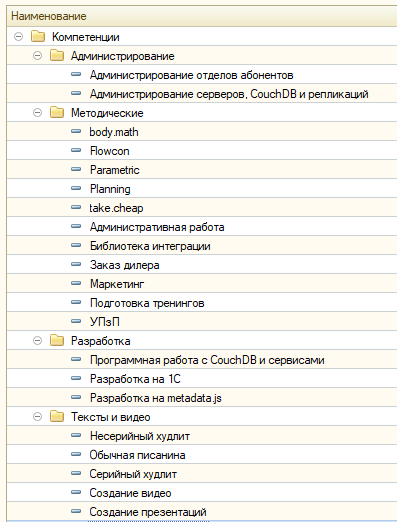
In general, there are no clear rules for completing this directory. In principle, he must solve three problems:
I, filling this directory, solved only the first two tasks. Targeted competencies have not yet invented.
I got four groups. Home - "Development", our main bread, whether it be services or the creation of products. As you may know, we develop on two platforms - 1C and metadata.js, and we use CouchDB as the DBMS. Hence the three core competencies in the design.
It was possible, of course, to break the same 1C development into separate competences, such as ACS, controlled forms, work with equipment, etc. But specifically, we do not need it - too long ago we are engaged in 1C.
The second most important section is “Methodical”. Simply put, it is the knowledge and understanding of specific products, on whatever platform they are implemented. You understand that it is not enough to know the programming language and the development environment - you also need to understand the architecture, processes and working patterns of a particular solution, its methodological component.
Then I also decided not to shallow, and just listed the products and services. “Administrative work” was crammed in here - did not know where to stick it. Well, “Marketing” as a type of work - it seemed to me more methodical.
Next - "Texts and video." This scribbling of all stripes and the creation of presentations, videos, etc.
Well, “Administration” - we do not have much of it, although the competence is very important, because we sell server rentals.
When developing competencies, the issue of data entry convenience immediately arose. It is clear that competence will have to be transferred somewhere, and not once. If data entry is inconvenient, or takes too much time, people just won't do it.
Therefore, the reference book “Competence Patterns” has appeared. An elementary container containing several competencies with distributed use shares. A kind of specification, as the composition of the product.
For example, this is how the template looks like, with which I evaluated the tasks for developing the 1Cn part of Flowcon:

The first line is the development, the second is the methodical one, the third is also the development, because Flowcon interacts with services and CouchDB quite a bit.
Well, then - full of buzz. I evaluated almost the entire flow of tasks on Flowcon with one template. How much time it took - I will write at the end of the article.
Everything is very simple here - competences are acquired from us in any way . More precisely, the system allows to “accrue” competencies in any way, even imaginary.
You can accrue competencies for solving problems. It is possible - for sales, or for efficiency gains, for passing the course, for reducing accounts receivable, for reporting on time, or just like that.
We have decided for ourselves that we will accrue competencies only for solved tasks.
In principle, there are three ways in a decision to accrue competencies:
Let's briefly go over accrual methods.
In tasks there is a “Competence” table in which you can list competencies or templates.

At first, I did a filling in according to a template — you choose it, and specific competencies fall into the table. Then he thought - damn, uncomfortable. You can simply specify a specific template, and in the reports dynamically pull out its contents.
He did. Most tasks, one way or another, are easily stratified into streams. Each stream, inside itself, contains tasks of the same type in terms of competencies. Let the template be specified in the task.
Additional fun brings the idea that the pattern can be changed. You never know, I was mistaken, put the share of competences incorrectly, or forgot to include some. If the tasks were the final competences, we would have to shovel them all. And now it is enough to change the template, and the numbers in the reports will change immediately.
It quickly became clear that it was not enough to indicate competences only in tasks. Firstly, not everyone uses exactly the bottleneck tasks. Secondly, if you started using tasks yesterday, what about the competencies gained in previous periods?
Moreover, the problem of past periods is relevant for us. We have been using tasks in Flowcon since November 2018, before that there was a githab with loading in 1C. I do not want to lose such a volume of data on competencies.
Therefore, we have made a separate table, a register of information in which the competencies are attached to any objects of the system. In our case - to the self-made reference book "Tasks Gitkhab".

Inside is a familiar competency plate. Similarly, you can specify a template.
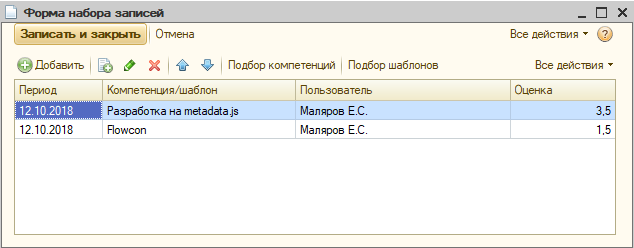
And so - for any object that we consider the carrier of tasks.
Option for smart, but lazy. If there are objects, the competencies for which are always charged the same way - for example, the same template - then why fill something in them every time? Let the layout work.
Just write a request that will return us objects, the period of accrual, employees, competence and evaluation. And everything, competences will be charged automatically.
Technically, the management of automatic accrual of competencies is managed by the “Autocompetence” reference book. It is simple and boring - you just need to specify the layout scheme, and set the flag to use auto-competence.
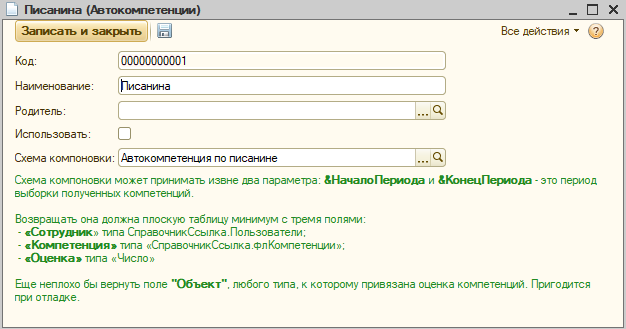
What is important: autocompetences do not store the results of charges anywhere, everything happens dynamically. We simply generate a report, it makes calculations on the fly and displays the result.
The advantages of this approach are obvious. Competences are such a thing that you constantly need to “play.” We simply change the layout scheme and get new data.
Another application of this approach is the modeling of different assessment systems. You can make two, or three different options for autocompetence, and look at the same data from a different angle.
When accruing competencies, it is important not only what develops, but also how much and when . For the quantitative assessment of competencies we use the same units as for the assessment of tasks - points, conventional units.
Nobody prevents other people from assessing competences in any other unit. For example, in hours and rubles. It is enough to indicate in the “Evaluation” field what is needed. Whatever unit you choose, it will still be clear only to you. The main thing is the dynamics.
An important parameter of the assessment is the “period” - this is the date to which we associate the acquisition of competencies. For example, for tasks, this is the date of execution. Creation date is not suitable, because Competence comes in the process of work, and this process can begin one year after the statement of the problem.
The period is needed for arbitrary objects, and for autocompetence. There is nothing difficult in determining the period, we just need not forget about it. Otherwise it would be wrong to consider the wear of competencies.
As we decided in the introduction, competencies tend to decrease. There we also came to the conclusion that some residue remains. We will assume that forever.
We decided to call this “decrease” of competencies wear.
It turns out that we need two values - the wear rate and the magnitude of the remainder. These parameters are stored in the settings.

Knowing that we have relative evaluations of competencies, the wear rate and the remainder can be expressed only as a percentage - so we did. The main question is what numbers to put?
To be honest, I do not know. And there is nobody to ask. And there is no need. The rate of wear can be determined by practice. I chose 50% per month - according to my observations, in two months it is already quite difficult to recall the competence. I chose 10% as a residue.
And here we have two values - the acquisition of competencies (income) and the wear and tear of competences (consumption). Not enough third - the remainder.
The rest is the coolest in competencies. This is a “fireproof amount”, a real baggage of knowledge, available without prior preparation. If desired, this is a specialist ROM. A person uses such competences as efficiently as possible - he just sits down and does it.
Or in other words: the balance of competencies is like savings in a bank, or reliable investments. Got income, put off 10%, and the rest - wasted. Well, that is, no wonder of course - one must eat, dress, have fun, etc. But in perspective, the costs of the current period do not play a special role, do not contribute to the future.
And investments - on the contrary, work for the future. Like the rest of the competencies.
Just in case, we have laid the possibility of controlling the rate of wear and the amount of the balance individually for each competence.
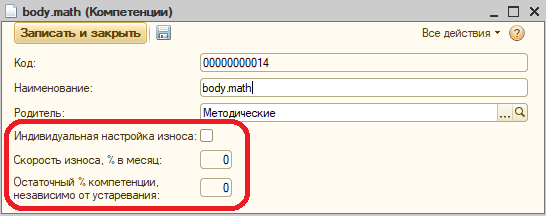
Having developed a system of accounting competencies, we began to apply it on ourselves. I, knowing that the speed of work with competencies is crucial, made measurements - the number of tasks and time.
So:
Since the tasks were old, I did not succeed in filling out quickly - I had to sit, remember what I was talking about. Moreover, I saw some tasks for the first time, because I evaluated not only myself. Sometimes it was necessary to stop and reflect on what elements to add to the reference book of competencies.
But the final figure pleased me - about 7.2 seconds per task. Dirty time - taking into account smoke breaks, tea drinking, opening and recording of objects.
3000 tasks in a year and a half are about 8 tasks a day for two. If you have a completed reference book of competencies and customized templates, it will take 57 seconds per day for the entire account . Gorgeous.
Accounting is good, but it is necessary to manage, including competencies. Accounting gives an insight into the current picture, how developed certain skills are, what is the remainder, in which direction and with what intensity the dynamics go.
Now you need to manage - to set a goal and move towards it. In competences, the goals are simple - to do something smaller, do something more.
Well, then - the details. Add a new competency, establish a target assessment for it, and solve problems on this topic. On the contrary - to reduce the use of some competence, if it interferes with the development of a specialist or a company as a whole. Change the balance of competences, giving priority to one to the detriment of others. Determine the profile of a specialist of a certain category, and track the real change of competences in order to avoid distortions.
All this, in Russian, is called “planning”, which is the basis of management. We can plan two parameters for competencies - volume (= assessment) and balance.
For planning, we have created a simple reference book called “Competence Profiles”. It simply lists the competencies, estimates and balance in percent. The reference book is multipurpose, and everyone can use it in their own way.
For example, I decided to change my current balance of competencies and wrote a target profile for myself:
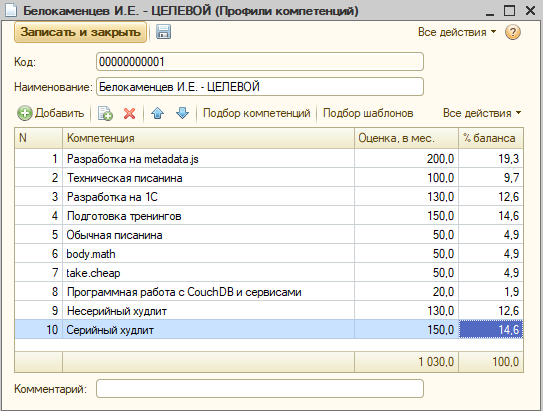
Another example - we decided to draw a developer profile. Estimates, for example, do not interest us - only the balance. His and fill:
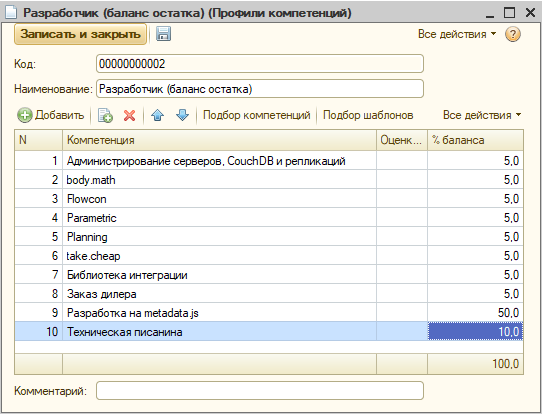
Now we can verify any employee with this profile and understand whether he is developing properly or not. Moreover, we can assess by the dynamics - for example, how competencies grew over the last month, and according to the remainder - what balance of fireproof competencies it has accumulated.
Profile conformity assessment is performed in reports.
The data is there, now they need to be seen. Now there are three competency reports in the system, but of them, with the help of settings, you can do a couple of dozen to answer specific questions.
When the practice of working with the system has accumulated, we will make new reports.
This is the most universal report. It simply displays data on the received competencies for the period. Collects from everywhere - from tasks, arbitrary objects and autocompetences.
Here are my competencies for a year and a half:
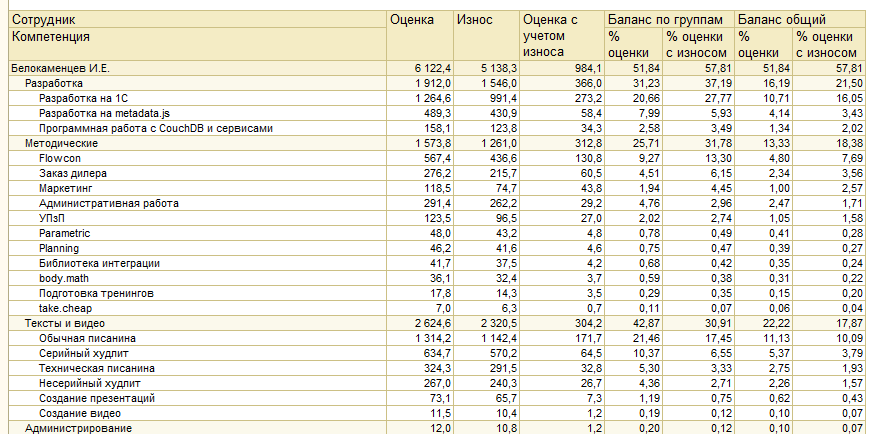
What is there to see? Well, I can see - see the upper left corner. You can see the hierarchy of competencies. Visible assessment - the arrival of skills for a year and a half. Wear is written side by side - how many competencies flowed into the pipe in a natural way. The balance, taking into account wear and tear, is evident that it is much lower than the arrival.
By the way, the data in the picture is sorted in descending order of the remainder, and it turns out to be a funny picture - the arrival by writing is more than the development, and the remainder is vice versa. What does this mean? For the last couple of months I have been fascinated by the development, and these competencies have not had time to evaporate.
Well, two groups of columns of actual balance. One shows the percentage in the current group ("Development", "Methodical", etc.), the other - in the total mass.
Let's test my hypothesis that lately I have been interested in development. We limit the period last month:

Well, yes, 70% - development. We'll see without employees, throughout the company for a year and a half:

Wonderful. Still, we are more developers than writers.
I do not know about you, but I do not like reports in the form of tables. It is necessary to peer, correlate, poke around. Without the usual reports, of course, nowhere, but you also need a graphical representation.
To display information in a graphical form, we made a report "Competence Chart". Here, for example, the profile of the rest of my competencies for a year and a half:
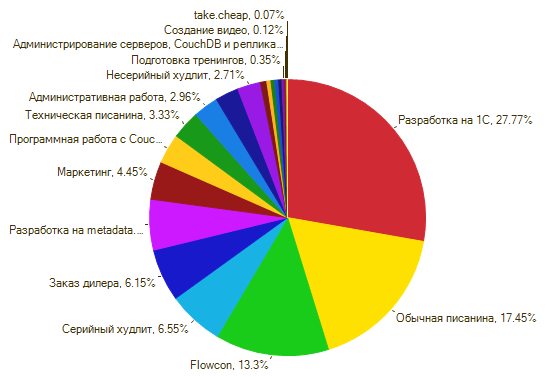
Or the histogram of competences of the entire company at the top level of the hierarchy:
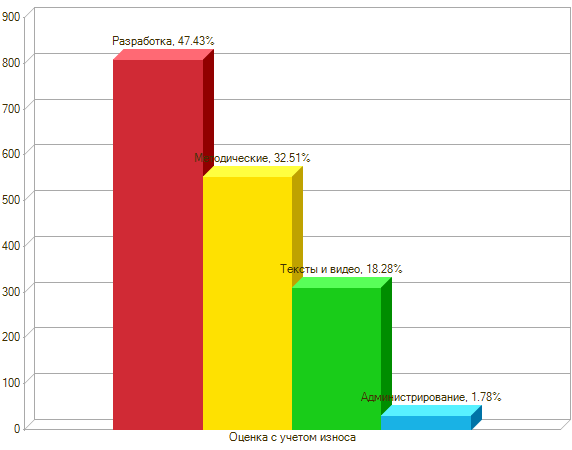
And here is a graph showing when we accumulated the competencies that we use now. Or in other words, this is the story of the accumulation of the rest of competencies.
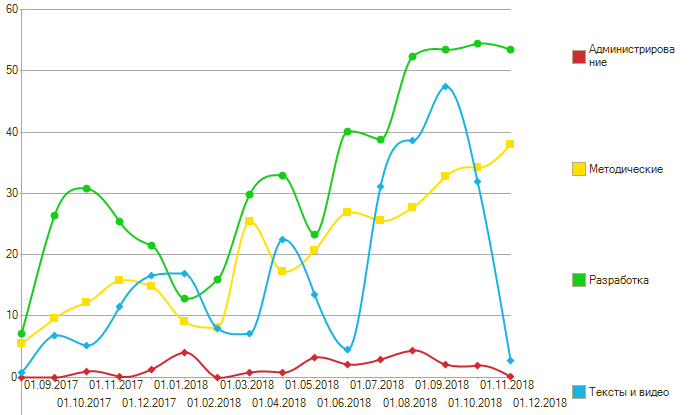
You can compare the competencies of people in a graphical form:

Or you can detail and compare the competencies related only to the development:
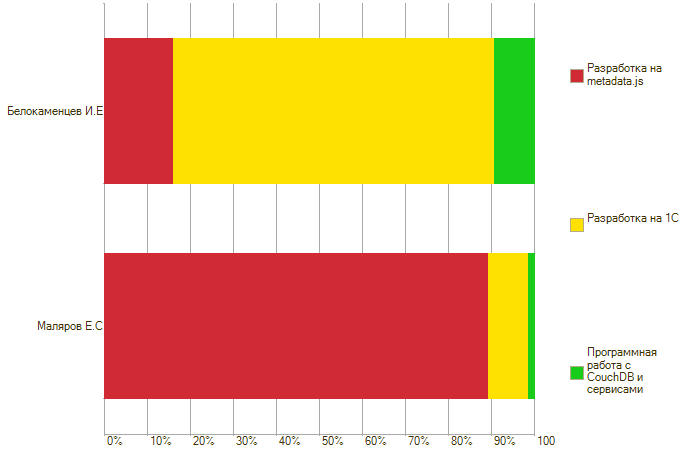
From this comparison, it is obvious why I put almost 20% of development on metadata.js in my target profile. Speaking of profiles.
This is a very simple report, and it was created for one purpose - to compare the plan and the fact. A plan is a competency profile. Fact - this is actually obtained for the period of competence.
Let us see how I correspond to the competency profile that I have compiled for myself:
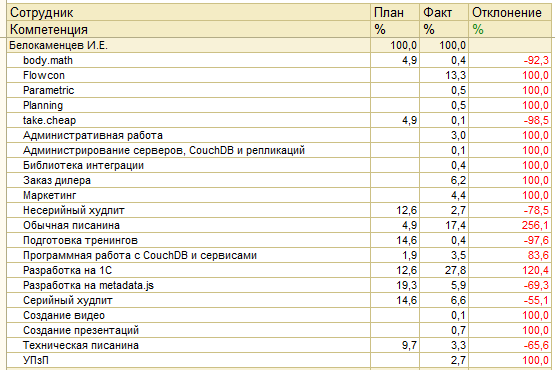
As you can see, there is only one redness — there is not a single competency corresponding to the target balance. This means that my competencies are not manageable and do not correspond to the company's strategy. It means that nothing can happen and it is necessary to change urgently.
For example, I made a profile of an abstract employee - a developer who could work with us. And I checked myself on this profile:

Pf ... Well, what kind of person am I ... So, tomorrow, I start a new life.
Reality, unfortunately, is terrible. Companies need one thing, employees do another. And I - including.
And so, until you know the numbers, you live quietly and you rejoice. Just do not understand why the company is not developing at the pace that you want to see. And the reason, it turns out, is in me.
Competences do not allow to sell new products, develop other markets, go beyond the framework of one country and in general. Well, everyone has his own "general".
As you wish, I will change. I'll start with myself.
I almost forgot. All this is done on 1C, for which I am, of course, ashamed. In your task manager, surely all this can be done easier and faster.
The phrase, though beaten, but I agree with her. Our business is exactly that. His success and failures are completely dependent on us, his employees. And it does not matter what kind of activities we are talking about - sales, marketing, development, maintenance, debugging, publishing, negotiations - all this is done by people , i.e. we.
And that's what happens. The success of a business depends on the competencies of its employees. We, like you, are trying to run a business. We count money, production, we manage tasks, we try to do something with projects, we calculate taxes ... We manage everything that is possible, except for what? Competences.
That is the most important thing we do not manage .
Competency issues
The first . We only roughly imagine what competencies we are talking about. Of course, if a business is built on performing one or two types of work, then management is not required. And if the types of work - dozens, and employees - hundreds?
What competencies do we already have? What is missing? What we dare not even threaten? What competencies do our clients need? A new product can we make, having only our competencies? Or maybe we lack one or two competencies to enter another market?
The second. We are poorly aware of the development of competencies. Approximately, in large strokes, we understand: Kohl is a specialist in the reactor, and Vasya is good at writing selling texts. And Gena? And who owns the angular? And what about the “Holding Management”? Do we have ERP competencies? And then everyone sells it, and we are on the sidelines. It seems that Seryoga knows something about ERP ... But what, and how well?
Third. We are accustomed to measure the acquisition of competencies by passing courses and certificates. Although we understand that real competencies are born only by practical work. But, since we do not measure the development of competencies, we have to be content with a surrogate - diplomas, courses and certificates. Undoubtedly, obtaining paperwork has a definite influence on competences, but this is only a starting impulse, followed by the application of theoretical knowledge in practice. But in reality, what happens with this impulse?
Fourth. Competences do not live in the head forever. Today I solved the task of a new technology for myself, I did not return to it for a couple of months, then I sat down - you do not remember anything. Some remnants of knowledge are present, of course, but "take and do" will not work anyway - you still have to figure it out. What can I say, even in your code, it is not always easy to figure out.
On the other hand, if competence is used regularly, then it comes to automatism and ceases to be a problem. It turns out that you need to measure and maintain this regularity in order not to lose competence.
The fifth . Business often depends on competencies. Sometimes - very much.
For example, if there is an employee with unique skills. If he leaves, the whole business line may close, at least for a while.
Competences often form a sales structure. If we have few ERP specialists, then a natural limit to the sales of services in this class of solutions is formed - it is equal to the physical ability to work out for these competent people. If competencies are not managed, then the business has to “get the volume” by other activities, often less in demand and more risky.
Sometimes the cart is placed in front of the horse. We form a sales portfolio based on competencies, and not vice versa . We train employees, pay money for it, and then we hope that sales will change, in terms of volume and structure.
But the reality remains in place - competencies manage the business . Form constraints that we have to take into account.
Sixth. There is a constantly smoldering conflict between employees and business, in terms of competencies. The person, as a rule, wants to “sit on the topic” - to master a small range of competencies, if possible - to become an expert in it, and take a considerable part of the work on the chosen topics.
A person is good, and business is not bad. But if a company needs to master new competencies? For business, this is a risk, for a person - all the more. Especially if for the development of new competencies do not pay extra. A person, trite, can stay on bread and water, executing the company's strategic plan.
Seventh. When we take a new employee, there are three options. If he is a great specialist or a carrier of unique competencies, then all is well - we took it purposefully, put it on, and we plug a hole in it, or we tie a new line of work on it.
If he is average in our core competencies, then he quickly integrates and just works. Not bad either - we increased the main flow of work.
And if he is a novice, then for some time falls under close attention. It happens, of course, that we just say - here is the computer, here is the task manager, sit down and work. But, as a rule, all have long had some kind of adaptation and training. We attach to the new mentor, give the theory and tasks for the selected competencies, and vigilantly monitor his progress.
The problem happens when a novice has completed the course of a young fighter. Man ** dissolves ** - in the mass of those same middling, ant business. While he was under the gun, we understood his competence and controlled them. When he joined, he became like everyone else. It seems like a nice guy. And what can? Yes, the devil knows ... That is all, that and he.
There are many problems with competencies, and we decided to defeat them. Automated work with competencies.
Competences
To begin with, we define what competences are. Let it be a hierarchical reference. In our case, it looks like this:

In general, there are no clear rules for completing this directory. In principle, he must solve three problems:
- be small;
- describe the current picture of competencies - what we already have;
- describe the target picture of competencies - which we don’t yet have, but we really need it.
I, filling this directory, solved only the first two tasks. Targeted competencies have not yet invented.
I got four groups. Home - "Development", our main bread, whether it be services or the creation of products. As you may know, we develop on two platforms - 1C and metadata.js, and we use CouchDB as the DBMS. Hence the three core competencies in the design.
It was possible, of course, to break the same 1C development into separate competences, such as ACS, controlled forms, work with equipment, etc. But specifically, we do not need it - too long ago we are engaged in 1C.
The second most important section is “Methodical”. Simply put, it is the knowledge and understanding of specific products, on whatever platform they are implemented. You understand that it is not enough to know the programming language and the development environment - you also need to understand the architecture, processes and working patterns of a particular solution, its methodological component.
Then I also decided not to shallow, and just listed the products and services. “Administrative work” was crammed in here - did not know where to stick it. Well, “Marketing” as a type of work - it seemed to me more methodical.
Next - "Texts and video." This scribbling of all stripes and the creation of presentations, videos, etc.
Well, “Administration” - we do not have much of it, although the competence is very important, because we sell server rentals.
Competency patterns
When developing competencies, the issue of data entry convenience immediately arose. It is clear that competence will have to be transferred somewhere, and not once. If data entry is inconvenient, or takes too much time, people just won't do it.
Therefore, the reference book “Competence Patterns” has appeared. An elementary container containing several competencies with distributed use shares. A kind of specification, as the composition of the product.
For example, this is how the template looks like, with which I evaluated the tasks for developing the 1Cn part of Flowcon:

The first line is the development, the second is the methodical one, the third is also the development, because Flowcon interacts with services and CouchDB quite a bit.
Well, then - full of buzz. I evaluated almost the entire flow of tasks on Flowcon with one template. How much time it took - I will write at the end of the article.
Acquisition of competencies
Everything is very simple here - competences are acquired from us in any way . More precisely, the system allows to “accrue” competencies in any way, even imaginary.
You can accrue competencies for solving problems. It is possible - for sales, or for efficiency gains, for passing the course, for reducing accounts receivable, for reporting on time, or just like that.
We have decided for ourselves that we will accrue competencies only for solved tasks.
In principle, there are three ways in a decision to accrue competencies:
- list them in a solved problem;
- list them in an arbitrary object;
- charge automatically without listing anything anywhere.
Let's briefly go over accrual methods.
Task competences
In tasks there is a “Competence” table in which you can list competencies or templates.

At first, I did a filling in according to a template — you choose it, and specific competencies fall into the table. Then he thought - damn, uncomfortable. You can simply specify a specific template, and in the reports dynamically pull out its contents.
He did. Most tasks, one way or another, are easily stratified into streams. Each stream, inside itself, contains tasks of the same type in terms of competencies. Let the template be specified in the task.
Additional fun brings the idea that the pattern can be changed. You never know, I was mistaken, put the share of competences incorrectly, or forgot to include some. If the tasks were the final competences, we would have to shovel them all. And now it is enough to change the template, and the numbers in the reports will change immediately.
Competences in arbitrary objects
It quickly became clear that it was not enough to indicate competences only in tasks. Firstly, not everyone uses exactly the bottleneck tasks. Secondly, if you started using tasks yesterday, what about the competencies gained in previous periods?
Moreover, the problem of past periods is relevant for us. We have been using tasks in Flowcon since November 2018, before that there was a githab with loading in 1C. I do not want to lose such a volume of data on competencies.
Therefore, we have made a separate table, a register of information in which the competencies are attached to any objects of the system. In our case - to the self-made reference book "Tasks Gitkhab".

Inside is a familiar competency plate. Similarly, you can specify a template.

And so - for any object that we consider the carrier of tasks.
Auto competence
Option for smart, but lazy. If there are objects, the competencies for which are always charged the same way - for example, the same template - then why fill something in them every time? Let the layout work.
Just write a request that will return us objects, the period of accrual, employees, competence and evaluation. And everything, competences will be charged automatically.
Technically, the management of automatic accrual of competencies is managed by the “Autocompetence” reference book. It is simple and boring - you just need to specify the layout scheme, and set the flag to use auto-competence.

What is important: autocompetences do not store the results of charges anywhere, everything happens dynamically. We simply generate a report, it makes calculations on the fly and displays the result.
The advantages of this approach are obvious. Competences are such a thing that you constantly need to “play.” We simply change the layout scheme and get new data.
Another application of this approach is the modeling of different assessment systems. You can make two, or three different options for autocompetence, and look at the same data from a different angle.
Estimates and periods
When accruing competencies, it is important not only what develops, but also how much and when . For the quantitative assessment of competencies we use the same units as for the assessment of tasks - points, conventional units.
Nobody prevents other people from assessing competences in any other unit. For example, in hours and rubles. It is enough to indicate in the “Evaluation” field what is needed. Whatever unit you choose, it will still be clear only to you. The main thing is the dynamics.
An important parameter of the assessment is the “period” - this is the date to which we associate the acquisition of competencies. For example, for tasks, this is the date of execution. Creation date is not suitable, because Competence comes in the process of work, and this process can begin one year after the statement of the problem.
The period is needed for arbitrary objects, and for autocompetence. There is nothing difficult in determining the period, we just need not forget about it. Otherwise it would be wrong to consider the wear of competencies.
Worn competence
As we decided in the introduction, competencies tend to decrease. There we also came to the conclusion that some residue remains. We will assume that forever.
We decided to call this “decrease” of competencies wear.
It turns out that we need two values - the wear rate and the magnitude of the remainder. These parameters are stored in the settings.

Knowing that we have relative evaluations of competencies, the wear rate and the remainder can be expressed only as a percentage - so we did. The main question is what numbers to put?
To be honest, I do not know. And there is nobody to ask. And there is no need. The rate of wear can be determined by practice. I chose 50% per month - according to my observations, in two months it is already quite difficult to recall the competence. I chose 10% as a residue.
And here we have two values - the acquisition of competencies (income) and the wear and tear of competences (consumption). Not enough third - the remainder.
The rest is the coolest in competencies. This is a “fireproof amount”, a real baggage of knowledge, available without prior preparation. If desired, this is a specialist ROM. A person uses such competences as efficiently as possible - he just sits down and does it.
Or in other words: the balance of competencies is like savings in a bank, or reliable investments. Got income, put off 10%, and the rest - wasted. Well, that is, no wonder of course - one must eat, dress, have fun, etc. But in perspective, the costs of the current period do not play a special role, do not contribute to the future.
And investments - on the contrary, work for the future. Like the rest of the competencies.
Just in case, we have laid the possibility of controlling the rate of wear and the amount of the balance individually for each competence.

Data entry speed
Having developed a system of accounting competencies, we began to apply it on ourselves. I, knowing that the speed of work with competencies is crucial, made measurements - the number of tasks and time.
So:
- I filled in competences in 3,000 tasks (this takes about a year and a half, for two);
- at the same time I filled out a reference book of competencies, templates;
- in parallel, I corrected the detected errors;
- I decided not to use autocompetence, i.e. processed all objects manually;
- I did all this in 6 hours.
Since the tasks were old, I did not succeed in filling out quickly - I had to sit, remember what I was talking about. Moreover, I saw some tasks for the first time, because I evaluated not only myself. Sometimes it was necessary to stop and reflect on what elements to add to the reference book of competencies.
But the final figure pleased me - about 7.2 seconds per task. Dirty time - taking into account smoke breaks, tea drinking, opening and recording of objects.
3000 tasks in a year and a half are about 8 tasks a day for two. If you have a completed reference book of competencies and customized templates, it will take 57 seconds per day for the entire account . Gorgeous.
Competency Profiles
Accounting is good, but it is necessary to manage, including competencies. Accounting gives an insight into the current picture, how developed certain skills are, what is the remainder, in which direction and with what intensity the dynamics go.
Now you need to manage - to set a goal and move towards it. In competences, the goals are simple - to do something smaller, do something more.
Well, then - the details. Add a new competency, establish a target assessment for it, and solve problems on this topic. On the contrary - to reduce the use of some competence, if it interferes with the development of a specialist or a company as a whole. Change the balance of competences, giving priority to one to the detriment of others. Determine the profile of a specialist of a certain category, and track the real change of competences in order to avoid distortions.
All this, in Russian, is called “planning”, which is the basis of management. We can plan two parameters for competencies - volume (= assessment) and balance.
For planning, we have created a simple reference book called “Competence Profiles”. It simply lists the competencies, estimates and balance in percent. The reference book is multipurpose, and everyone can use it in their own way.
For example, I decided to change my current balance of competencies and wrote a target profile for myself:

Another example - we decided to draw a developer profile. Estimates, for example, do not interest us - only the balance. His and fill:

Now we can verify any employee with this profile and understand whether he is developing properly or not. Moreover, we can assess by the dynamics - for example, how competencies grew over the last month, and according to the remainder - what balance of fireproof competencies it has accumulated.
Profile conformity assessment is performed in reports.
Reports
The data is there, now they need to be seen. Now there are three competency reports in the system, but of them, with the help of settings, you can do a couple of dozen to answer specific questions.
When the practice of working with the system has accumulated, we will make new reports.
Report "Competences"
This is the most universal report. It simply displays data on the received competencies for the period. Collects from everywhere - from tasks, arbitrary objects and autocompetences.
Here are my competencies for a year and a half:

What is there to see? Well, I can see - see the upper left corner. You can see the hierarchy of competencies. Visible assessment - the arrival of skills for a year and a half. Wear is written side by side - how many competencies flowed into the pipe in a natural way. The balance, taking into account wear and tear, is evident that it is much lower than the arrival.
By the way, the data in the picture is sorted in descending order of the remainder, and it turns out to be a funny picture - the arrival by writing is more than the development, and the remainder is vice versa. What does this mean? For the last couple of months I have been fascinated by the development, and these competencies have not had time to evaporate.
Well, two groups of columns of actual balance. One shows the percentage in the current group ("Development", "Methodical", etc.), the other - in the total mass.
Let's test my hypothesis that lately I have been interested in development. We limit the period last month:

Well, yes, 70% - development. We'll see without employees, throughout the company for a year and a half:

Wonderful. Still, we are more developers than writers.
Competence Chart Report
I do not know about you, but I do not like reports in the form of tables. It is necessary to peer, correlate, poke around. Without the usual reports, of course, nowhere, but you also need a graphical representation.
To display information in a graphical form, we made a report "Competence Chart". Here, for example, the profile of the rest of my competencies for a year and a half:

Or the histogram of competences of the entire company at the top level of the hierarchy:

And here is a graph showing when we accumulated the competencies that we use now. Or in other words, this is the story of the accumulation of the rest of competencies.

You can compare the competencies of people in a graphical form:

Or you can detail and compare the competencies related only to the development:

From this comparison, it is obvious why I put almost 20% of development on metadata.js in my target profile. Speaking of profiles.
Report “Compliance with the profile of competencies”
This is a very simple report, and it was created for one purpose - to compare the plan and the fact. A plan is a competency profile. Fact - this is actually obtained for the period of competence.
Let us see how I correspond to the competency profile that I have compiled for myself:

As you can see, there is only one redness — there is not a single competency corresponding to the target balance. This means that my competencies are not manageable and do not correspond to the company's strategy. It means that nothing can happen and it is necessary to change urgently.
For example, I made a profile of an abstract employee - a developer who could work with us. And I checked myself on this profile:

Pf ... Well, what kind of person am I ... So, tomorrow, I start a new life.
Total
Reality, unfortunately, is terrible. Companies need one thing, employees do another. And I - including.
And so, until you know the numbers, you live quietly and you rejoice. Just do not understand why the company is not developing at the pace that you want to see. And the reason, it turns out, is in me.
Competences do not allow to sell new products, develop other markets, go beyond the framework of one country and in general. Well, everyone has his own "general".
As you wish, I will change. I'll start with myself.
PS
I almost forgot. All this is done on 1C, for which I am, of course, ashamed. In your task manager, surely all this can be done easier and faster.
